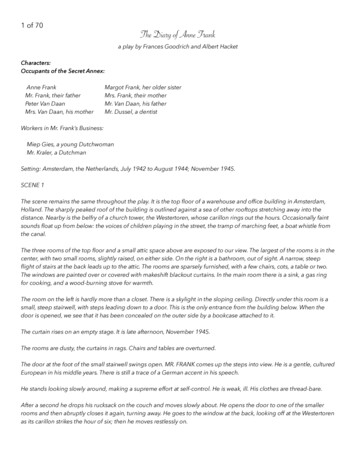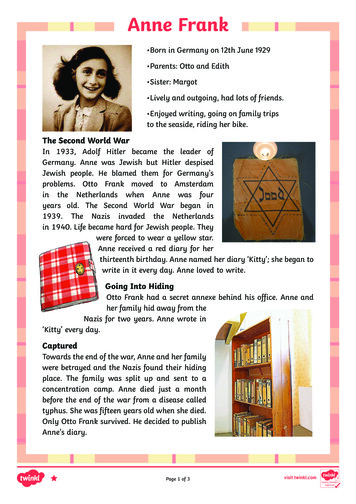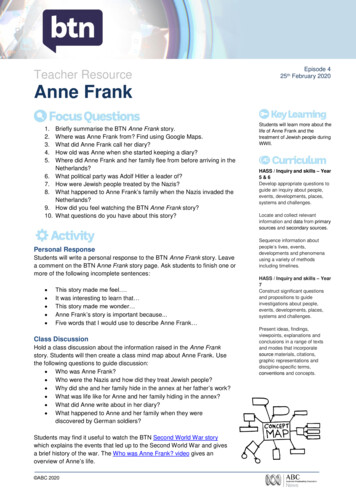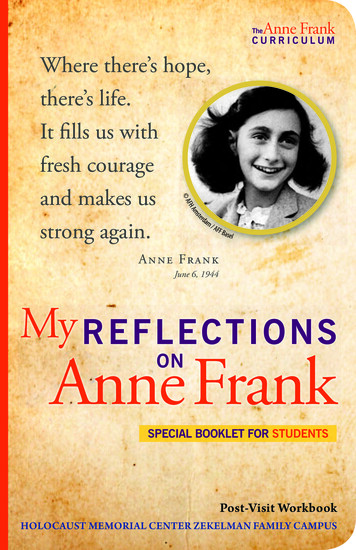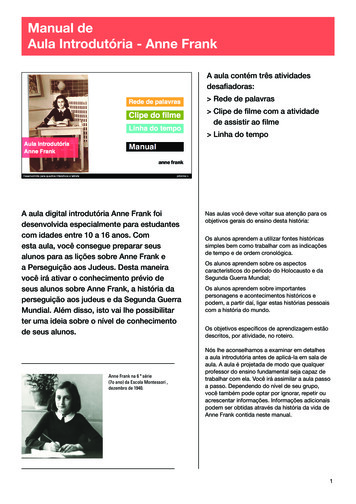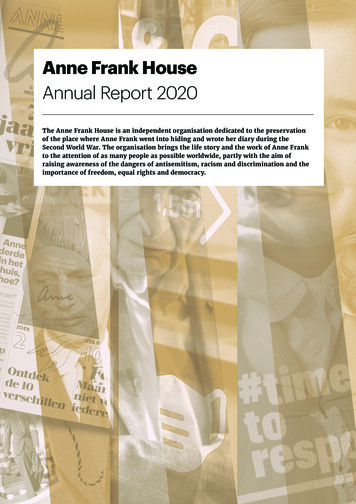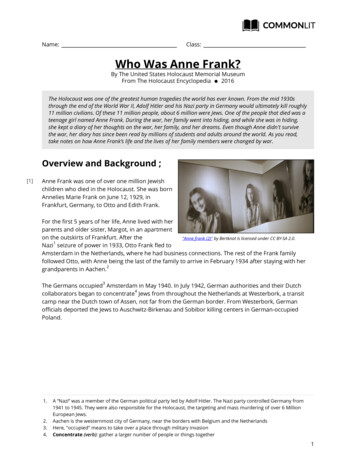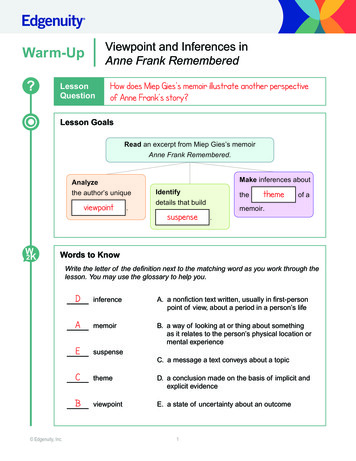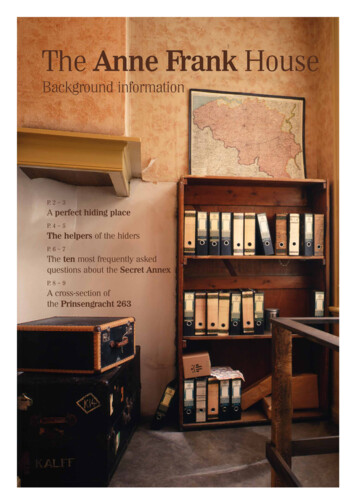
Transcription
The Anne Frank HouseBackground informationP. 2 – 3A perfect hiding placeP. 4 – 5The helpers of the hidersP. 6 – 7The ten most frequently askedquestions about the Secret AnnexP. 8 – 9A cross-section ofthe Prinsengracht 263
A perfecthiding placeThe 1942 summer holiday had just started. Anne Frank was in the first year of the JewishLyceum in Amsterdam. She had moved up and was happy with her report, havingreceived only one unsatisfactory mark. On Sunday 5 July, she was relaxing in the sun onthe roof terrace when the doorbell rang Anne’s mother opened the door to a police officer who was delivering a special postcardstating that Margot, Anne’s older sister, was to present herself to go off to work in NaziGermany. The card did not come as a surprise because there were numerous rumoursthat this might happen. On that same Sunday, about 1,000 Jews in Amsterdam receiveda similar card.2GOING INTO HIDINGSEVERE PUNISHMENTSAnne’s parents were well-prepared and did not trust the Nazisat all. Margot would not present herself; instead the entire familywould go into hiding. Their shelter was almost ready. Two floorshad been furnished and stocked with food in the Secret Annex an empty part of a building owned by Anne’s father Otto Frank’scompany.Otto also asked Victor, Miep and Bep if they would be willingto help them if the families were to go into hiding and they allimmediately agreed. The helpers realised that their own life wasat risk because there were severe penalties for helping Jews;the men in the warehouse and the neighbours were not to knowanything about it.OPEKTA AND PECTACONANNE’S DIARYOtto Frank’s company was located at the Prinsengracht, in thecentre of Amsterdam. It actually consisted of two companies:Opekta and Pectacon. Opekta sold an ingredient for preparinghomemade jam; Pectacon sold meat and sausage seasoning.Miep Gies, Victor Kugler, Johannes Kleiman, Hermann van Pelsand Bep Voskuijl worked in the office. Hermann van Pels was alsoJewish. In addition, a few men worked in the warehouse.And then there was the call on 5 July. Early next morning, thefamily left to their hiding place. Anne brought a bag with textbooks,a few old letters and her diary.FURNITURE AND FOODIn the spring of 1942, Otto Frank and Hermann van Pels decidedto furnish a hiding place. Johannes Kleiman and his brother Willyhelped them and together they took as much furniture and food tothe Secret Annex as possible.EIGHT HIDERSOne week later, the Van Pels family joined them: Hermann andAuguste and their son Peter. In late 1942, Miep told them that FritzPfeffer, Miep’s dentist and an acquaintance of the Frank family,was looking for a hiding place. On 16 November 1942, he alsowent into hiding in the Secret Annex.A PERFECT HIDING PLACEAnne referred to the hiding place as ‘perfect’ in her diary. Accordingto her, there was no other place in the Netherlands like it for hiders.But the eight hiders had no idea how long their stay would be.
8hidersOTTO FRANKEDITH FRANKHERMANN VAN PELSAUGUSTE VAN PELSMARGOT FRANKANNE FRANKPETER VAN PELSFRITZ PFEFFERTHE DIARY ANNE GOTFOR HER THIRTEENTHBIRTHDAY.EDITH FRANK WITH ANNE, 13 JUNE 1929. What happenedbefore all this 28,000hidersAnne Frank was born on 12 June 1929 and lived with her father, motherand sister Margot in Frankfurt-am-Main, Germany. The Frank family wasJewish. In 1933, Adolf Hitler and his party came into power. Hitler andhis supporters (Nazis) were anti-Semitic and hated Jews. Jews wereincreasingly discriminated against and Anne’s parents, Otto and EdithFrank, decided to move to Amsterdam that very year. They felt safe inthe Netherlands.During the Second World War, about 28,000 Jewish men,women and children in the Netherlands succeeded infinding a hiding place. Families seldom remained togetherand parents were often separated from their children. Inmany cases, siblings went into hiding at different locations.Some of them received a false name and they could go toschool and play outside as if they were not Jewish. Hidersoften moved around to other places after short periods oftime; many of them had to relocate to another hiding placefrequently because of the danger of being betrayed. Hidingplaces were usually much smaller than the Secret Annex,in some cases not even bigger than a crawl space. TheNazis deported a total of 107,000 Jewish men, women andchildren from the Netherlands to the concentration camps.Only 5,000 survived.On 10 May 1940, German forces invaded the Netherlands and warbroke out. The Dutch army was forced to give up the fight after fivedays and the German army occupied the Netherlands. Jews werediscriminated against and persecuted here also: the Nazis forbadethem to visit swimming pools, cinemas, libraries and many other publicplaces. After the 1941 summer holiday, all Jews had to go to Jewishonly schools and from May 1942, the occupiers forced every Jew in theNetherlands older than 6 to wear a yellow star stating the word ‘Jew’on their clothing.On 12 June 1942, Anne received a diary from her mother and fatherfor her thirteenth birthday. She was very happy with it, but a few weekslater, life as she knew it was over 3
The helpersof the hidersAnne wrote a lot about the helpers in her diary. The persons in hiding were very gratefulfor all of the help and care they received from them. But who exactly were these helpersand what did they do?4OTTO FRANK AND THEHELPERS, OCTOBER 1945.FROM THE LEFT TOTHE RIGHT: MIEP GIES,JOHANNES KLEIMAN,OTTO FRANK, VICTORKUGLER, BEP VOSKUIJL.AT THE TOP: JAN GIES.MIEP GIES, 1909 – 2010 JAN GIES, 1905 – 1993 Miep Gies started working for Otto Frank’s company in 1933. In aninterview, she later explained how the tasks were divided betweenthe helpers: ‘Bep took care of bread and milk, Kugler and Kleimankept the company going and brought books and magazinesfor the hiders, and I looked after vegetables and meat.’ Miep’shusband Jan also helped the people in the Secret Annex. He wasin the resistance and was able to get distribution coupons thatwere needed to buy food.VICTOR KUGLER, 1900 – 1981 Victor Kugler worked for Otto Frank’s company from 1933. He wasinitially involved in selling pectin (Opekta), and later mainly in the saleof meat and sausage seasoning. Victor refrained from returningpart of these profits to the tax authorities and used the moneyfor the hiders. He often brought magazines and newspapers forthem and made Anne happy with the weekly Cinema & Theatermagazine. After the war, Victor Kugler explained why he hadhelped them: ‘I had to help; they were my friends.’JOHANNES KLEIMAN, 1896 – 1959 Otto Frank had known Johannes Kleiman for a very long time. In1923, Otto Frank tried to open a bank in Amsterdam and workedtogether with Johannes Kleiman. From 1940, Kleiman worked forOtto Frank’s company and after the war he told why he had helpedthe hiders. He referred to Otto Frank as a ‘serious businessmanand a very decent and helpful person’. This was enough for him.BEP VOSKUIJL, 1919 – 1983 Bep Voskuijl started working for Otto Frank’s company before thewar and she was the youngest employee. Bep had just turned23 when the Frank family went into hiding in the Secret Annex.According to Otto Frank, Anne and Bep got along fine, oftenchatting in a corner. After the war, Bep was often asked aboutAnne and the Secret Annex. In a letter to Otto Frank, she wrotethat: ‘it always made her think of what had happened’ and whatshe had witnessed. She was very sad that Otto Frank was the onlyone of the family who survived the concentration camps.
VIKTOR KUGLER, BEP VOSKUIJL AND MIEP GIES(FROM LEFT TO RIGHT) IN THE OFFICE AT THECANAL SIDE OF THE HOUSE, 1941. THE GIRLS INTHE BACK NO LONGER WORKED THERE WHENTHE FRANK FAMILY WENT INTO HIDING.ABOVE: THE OFFICE TEMPORARILY FURNISHEDFOR A FILM SET.‘We, the helpers, knewthat we all had problemswith the situation fromtime to time, but we neverspoke about it. Everythinghad to go smoothly andtalking about things wouldonly put pressure onus. It would cause us tothink about the personsin hiding all day long andwe had to prevent that. Wehad to appear as relaxedas possible to the outsideworld, or people might getsuspicious.’Miep Giesin an interviewin 1998. Betrayed!Friday 4 August 1944 seemed a day like any other in theSecret Annex. It was Anne’s 761st day in the hiding place.The hiders were quietly working when suddenly, Dutchpolice officers came in. Karl Josef Silberbauer, an Austrianmember of the SS, was in charge. The hiders had beenbetrayed. They were arrested and forced to hand over theirjewellery and other valuables. The SS man carelessly shookout a briefcase to put the things in it. It was the briefcasein which Anne kept her diary papers. and they all fell tothe ground.The hiders were arrested and Johannes Kleiman andVictor Kugler were also taken because they helped theJews. Miep and Bep were left alone. After the truck withthe prisoners had left, they returned to the hiding place tocollect as many of the hiders’ belongings as possible. Afew days later, the Dutch company Puls emptied the entireSecret Annex by order of the Nazis. Anything usable wastransported to Germany.5
A N K , 19 40A N N E FREvery year, about one million people from all over theworld visit the Anne Frank House. What are the tenmost frequently asked questions about the hiders, thehelpers and the Secret Annex?THE ROOM OF ANNE FRANK ANDFRITZ PFEFFER, TEMPORARILY FURNISHEDFOR A FILM SET.1WHO MADE THE BOOKCASE THAT HID THEENTRANCE TO THE HIDING PLACE?The bookcase was made in August 1942 by JohanVoskuijl, Bep’s father, who worked in the warehouse. Hedid not know anything about the hiders at first, but theyconfided in him later.62WHY DID FRITZ PFEFFER HAVE TO SHARE AROOM WITH ANNE?The 10askedabout theIn an interview, Miep Gies later said: ‘It was an emergencysituation and we didn’t give it any further thought’. Inaddition, there was no other place available and Annewas still considered a child, unlike Margot.3WHEN STANDING IN FRONT OF PRINSENGRACHT 263, IT IS IMPOSSIBLE TO SEE THE SECRETANNEX, BUT IT IS VISIBLE FROM THE COURTYARD AND FROM THE WESTERTOREN. WHY WERE THEHIDERS NOT DISCOVERED SOONER?The Nazis held major raids in order to track Jews; they closed off entire streets or neighbourhoods and would go from houseto house to arrest Jewish occupants. But the Nazis held hardly any raids in the centre of Amsterdam. From late 1943, the raidsoccurred less often because most Jewish people living in the Netherlands had already been transported to the concentrationcamps via Westerbork.4WHAT DID THE HIDERS DO DURING THE DAY?The hiders were usually very quiet during the day and read, study or did household chores. The most dangerous hours werebetween 8.30 and 9.00 am, when the employees in the warehouse were already working. They were not to notice anything, sothe hiders had to wait until 9.00 am when the helpers came in before they could use the bathroom, for instance.When the warehouse employees went home for lunch, the hiders could heave a sigh of relief. One of the helpers would come in,join the meal and bring the latest news from the city. After lunch, everyone had to be as quiet as possible again until the evening,when all of the warehouse employees would go home.5HOW WAS ANNE FRANK’S DIARY PRESERVED?After the arrest, Miep and Bep went to the hiding place and saw Anne’s diaries, notebooks and notes lying on the floor. Miep puteverything in a drawer of her desk with the intention of returning it to Anne after the war. When Otto told her that Anne had diedin the Bergen-Belsen concentration camp, Miep gave the notebooks to him.
THE MODELS OTTO FRANKHAD MADE IN 1960 PROVIDEA GOOD IMPRESSION OFTHE DESIGN OF THE HIDINGPLACE.Why isn’t there anyfurniture in the SecretAnnex?most frequentlyquestionsSecret Annex6Shortly after the museum opened its doors in1960, Otto Frank had special models madeto provide visitors with an impression of thedesign of the Secret Annex. In an interview,he said: “After the Anne Frank House wasrenovated, I was asked whether the roomshad to be refurnished, but I said no. Duringthe war [after the arrest – ed.] everythingwas removed and I want to keep it that way.But after the opening of the house, peopleindicated that the rooms were very spacious.I answered that they had a faulty impressionand said: ‘Don’t forget the unbearable andunending tension.’”When did Otto Frank die?Otto Frank reached the age of 91; he wasborn on 12 May 1889 in Frankfurt am Mainand died on 19 August 1980.What happened to the hiders and the two helpers after their arrest?The eight hiders were deported to Auschwitz-Birkenau via Doorgangskamp Westerbork and died there or someplace else aftersubsequent transports. Otto Frank was the only one to survive the persecution of the Jews.Johannes Kleiman was imprisoned in the Amersfoort camp and was released after a while. In 1945, Victor Kugler escaped froma train that was on its way to Germany.What happened to the police officers who arrested the hiders?Karl Joseph Silberbauer, the SS man in charge of the raid, was tracked down by Simon Wiesenthal in 1963 in Vienna, where heworked for the police. He was suspended, but was later allowed to go back to work. He died in 1972.Two Dutch officers, Gezinus Gringhuis and Willem Grootendorst, received long prison sentences for what they had done as ‘Jewhunters’ during the war. The arrest of the hiders in the Secret Annex was not of particular significance in this. Grootendorst diedin 1973 and Gringhuis in 1975.Who betrayed the hiders?A few investigations took place after the war and there were suspects, but no evidence was ever found and it remains unknownwho did it.For more information, go to: www.annefrank.org/nl/betrayal778910
PRINSENGRACHT, 1949Prinsengracht263This section shows the Prinsengracht 263 with furniture like it was when occupied by those in hiding. Today,the Annex isn’t furnished (see question 6 on page 7), but the models provided by Otto Frank give a good ideaand Anne described the canalside of the house and the annex in her diary. There are even floor plans thatwere retained! Thanks to this information, we now know what the building looked like at that time, and thehistorical model is based on this knowledge. A few renovations took place later, as a result of which some ofthe doors, walls and windows are no longer in their original location.89 12345678910111213141516WarehouseWarehouse bathroomOffice kitchenOffice bathroomDoor to executive officeVictor Kugler’s officeOffice of Miep Gies,Johannes Kleiman andBep VoskuijlStorage roomsCanal side of the house atticThe bookcaseRoom of Otto, Edith andMargot FrankRoom of Anne Frank andFritz PfefferWashroomRoom of Hermann andAuguste van PelsRoom of Peter van PelsSecret Annex attic8761
Want to knowmore? THE DIARY OF A YOUNG GIRLAnne’s diaries are available in an edition compiledand edited by Otto Frank and later by MirjamPressler, and known in the Netherlands underthe title Anne came up with: The Secret Annex(Het Achterhuis). English edition: Penguin Puffin,ISBN 9780141315188THE SECRET ANNEX ONLINEOn this educational website, the Anne Frank Houseprovides an impression of the hiding place as it wasduring the war.Go to www.annefrank.org/WHO WAS WHO IN AND AROUND THESECRET ANNEX?A further acquaintance with the thirteen people – thehiders and helpers – we will never forget because ofAnne Frank’s diary.Ordering via www.annefrank.org/shopOUTSIDE IT’S WARAnne Frank and her world16By Janny van der Molen, with drawings by Martijnvan der Linden.In collaboration with the Anne Frank House,Uitgeverij Ploegsma developed a book about AnneFrank for children eight years and up. It provides animage of Anne’s life using short stories.ISBN 978 90 216 7245 8141513ANNE FRANKThe graphic biography11By Sid Jacobson and Ernie Colón.This graphic biography for readers aged 14 yearsand up starts with the life of Anne Frank’s parents– Otto en Edith – and the first years of the sistersAnne and Margot in Frankfurt. The biography endswith the publication of Anne’s diary texts and theopening of the Anne Frank House. US edition: Hill &Wang, a division of Farrar, Straus & GirouxISBN 978 0 8090 2684 512105342COLOPHONThis booklet is part of: The Anne Frank House – an historical cardboard model,a publication of the Anne Frank House, Anne Frank Stichting, Amsterdam 2013Project management: Anne Frank House (Chantal d’Aulnis)Project coordinator: Anne Frank House (Eugenie Martens)Editors: Anne Frank House (Menno Metselaar), Mans KuipersTranslation: Vertaalbureau Noorderlicht B.V.Design of the cardboard model: Wouter BiegelaarProduction: Bouwen VouwenDesign of this booklet: frenz.to (Francis Nijenhuis and Theo Heldens)Photos: Photo collection of the Anne Frank Stichting, Amsterdam. PhotoAviodrome, LelystadIllustrations and building instructions: Wouter BiegelaarIllustration of the cross-section: Vizualism (Frédérik Ruys and Chantal van Wessel)Copyright third party quotes: the individual entitled parties9
Bep Voskuijl started working for Otto Frank's company before the war and she was the youngest employee. Bep had just turned 23 when the Frank family went into hiding in the Secret Annex. According to Otto Frank, Anne and Bep got along fine, often chatting in a corner. After the war, Bep was often asked about Anne and the Secret Annex.
